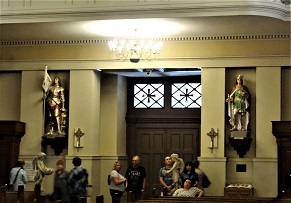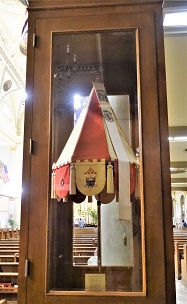


|
|
||||||||||||||||
|
|
||||||||||||||||
|
|
|||
|
|
New Orleans Cathedral Basilica of St Louis
Located in the French Quarter of New Orleans, the Cathedral Basilica of St. Louis King of France, known as the “Old” Cathedral, is the oldest cathedral in the United States. The parish dates back to the 18th century when a log church was first built on the site in the early 1700s. This log structure was replaced in 1727 by a new church dedicated to Louis IX, sainted King of France. It took three years to build and was perhaps the first building in New Orleans using "briques-entre-poteaux” construction, where bricks were laid between upright and diagonal posts and covered in stucco, an effective method of building that continued to be used in Louisiana until at least the middle of the nineteenth century. Erected between 1724 and 1727, this original church building was destroyed in the great fire of New Orleans in 1788. In 1789, a second church was begun and was dedicated as a cathedral on Christmas Eve of 1794. In 1818, Bishop DeBourg, Bishop of Louisiana and The Floridas, took up resistance at St Louis Cathedral, and, in 1819, he had a central tower with a clock and bell added. The bell was cast in France and embossed on it in French is a dedication to the victory by the Americans over the British on 8 January 1815 at the Battle of New Orleans, led by General Andrew Jackson, later President of the United States. In 1849, work began to enlarge and restore the cathedral. During this work, everything except the lateral walls and the lower portions of the existing towers on the front facade was demolished. During the course of this work, the central tower collapsed with the consequence that very little of the previous structure survived. The work carried out between 1849-1851 resulted in it essentially being completely rebuilt. Consequently, the current cathedral mainly dates from 1850, when it was designated as the Metropolitan Church of the Archdiocese of New Orleans. The bell from the 1819 tower was saved and reused in the new building and continues to ring today. In 1961, Pope John XXIII officially granted it the name Cathedral of St. Louis King of France. Pope Paul VI bestowed upon the cathedral the rank of Minor Basilica in 1964. The interior of the Basilica displays objects dating from throughout its history. The high altar was installed in 1852 and comes from Belgium. It is supported by four statues of angels. Above the altar screen is a classical entablature and pediment supported by six fluted Corinthian columns. Above the main altar is a mural depicting King Louis IX (1214-1297) announcing the 7th Crusade (1248-1254). Within the central nave hang two rows of flags. On one side hang the official flags of Louisiana from over the years, and on the other hang the coats-of-arms of the ecclesiastical provinces of New Orleans. Over the nave and sanctuary is a vaulted ceiling with murals depicting scenes from the life of Christ and the evangelists. The apostles, with the exception of Peter and Judas, are portrayed on the walls of the nave. The lower stained-glass windows come from Germany and date from 1929. These depict events in the life of King Louis. On one side of the main entrance stands a statue of King Louis, who was declared a saint in 1297. Below this statue is displayed a copy of the bible that belonged to St Louis. The original, produced between 1226 and 1234 in Paris, is in the Cathedral of Toledo, Spain. A copy was made in 2000 which was presented to the New Orleans cathedral by Deacon Ronald L. Guidry in 2007. On the other side of the entrance is a statue of St Joan of Arc. On either side of the main aisle stand angels holding fonts for the holy water.  The symbol of the cathedral’s basilica status is the red and yellow Umbrellino, which is an umbrella made of wood with alternate panels of red and yellow silk. This was once used on a daily basis to provide shade for the pope, now it is a piece of the papal regalia and insignia.  The cathedral is infamous for being the burial place of the Voodoo priestess Marie Laveau (1801-1881) who is known as the Voodoo Queen of New Orleans. She was buried in the cathedral’s cemetery, which is situated at the rear of the cathedral, something which in itself is an attraction for visitors. Although the cemetery is not open to the public, access is available through tour companies who pay an annual fee for the privilege. Several events have caused damage to the cathedral over the years. In 1909, dynamite was set off inside the building (purportedly by disgruntled workmen), causing damage to the galleries and blowing out some of its windows. Undermining of the foundations was discovered in 1916, necessitating repairs that closed the building for about a year. The cathedral also suffered damage during Hurricane Katrina in 2005.
Just a short walk away, in the old Ursuline convent, is the cathedral museum. It contains many artifacts from the early days of this church, and also contains information relating to the history of the parish community.
To see more photographs and take a virtual tour of the site click on the photoshow below. |
|
|
|
|
|||
All Photographs were taken by and are copyright of Ron Gatepain
| Site Map |